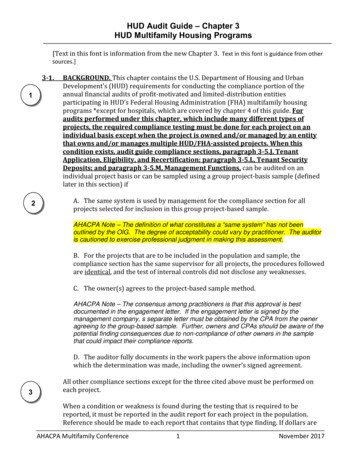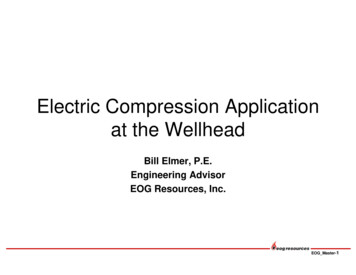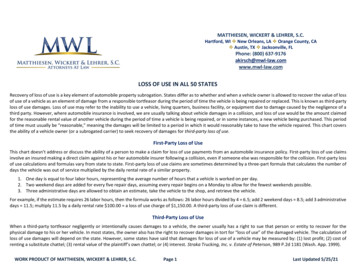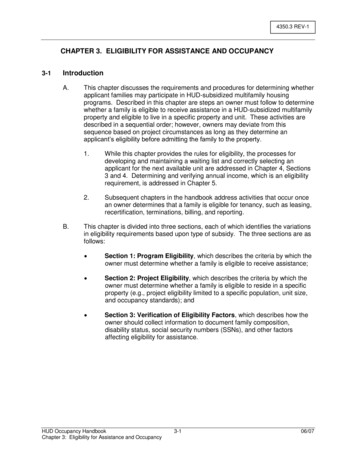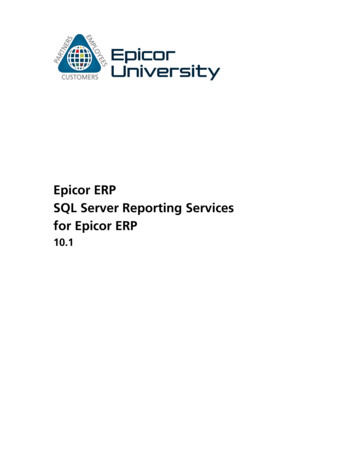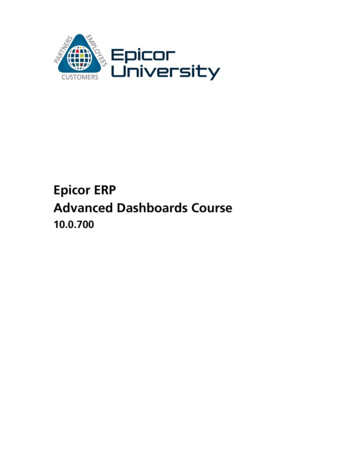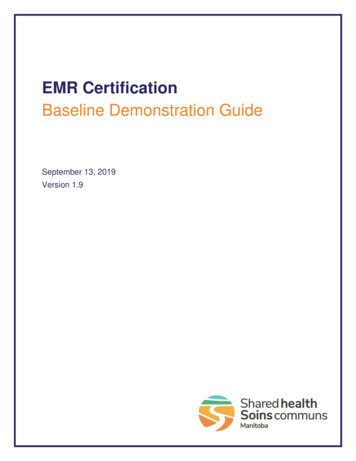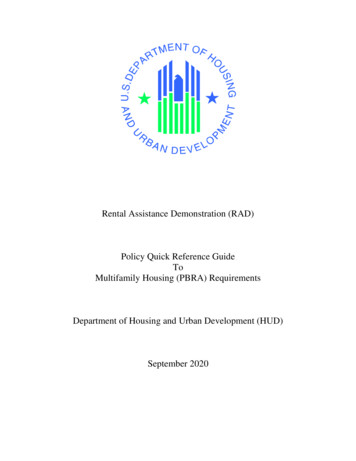
Transcription
Rental Assistance Demonstration (RAD)Policy Quick Reference GuideToMultifamily Housing (PBRA) RequirementsDepartment of Housing and Urban Development (HUD)September 2020
Table of ContentsSECTION ONE – INTRODUCTION . 11.1Purpose of this Guide . 11.2Background . 1SECTION TWO – OCCUPANCY REQUIREMENTS AT CONVERSION . 22.1Affirmative Fair Housing Marketing Plan . 22.2Tenant Selection Plan . 32.3Program Eligibility . 42.4Social Security Numbers . 42.5Citizenship. 42.6Mixed Families . 52.7Elderly Designation . 52.8Preferences . 52.9Waiting List . 72.10Lease Agreement and other Required Documents . 82.11Pets . 92.12Utility Allowances. 92.13Resident Rights and Participation . 102.14Tracking Households Housed Prior to RAD Conversion . 102.15PIH Provisions Continuing After Conversion . 102.16Determining Income and Calculating Rent . 122.17Security Deposits. 13SECTION THREE – MONITORING . 143.1Management and Occupancy Reviews (MORs) . 143.2Physical Inspections . 143.3Financial Requirements . 15SECTION FOUR – RESOURCES . 15Attachment 1: Clarifications of Occupancy Requirements After Conversions . 17Attachment 2: Section 202 PRAC Conversions Under RAD . 25Attachment 3: Rent Phase-In Procedure . 26Attachment 4: Pet Addendum for Former Section 202 PRAC Properties . 27Attachment 5: House Rule Provisions Required by RAD . 28
Attachment 6: FSS Escrow Account Credit Worksheet . 30Attachment 7: Sample Family Self-Sufficiency Information Page . 31Attachment 8: Approving the Delay of a Physical Inspection Memo . 33
SECTION ONE – INTRODUCTION1.1Purpose of this GuideThis guide provides guidance for occupancy related policy to owners (including PublicHousing Agencies) converting their projects to Section 8 Project-Based Rental Assistance(PBRA) authorized under the Rental Assistance Demonstration (RAD). The purpose ofthis guide is not to be all-inclusive or overly descriptive of HUD Multifamily Housingprogram requirements but rather to highlight certain requirements owners convertingunder RAD should be aware of. The guide is a starting point for owners converting underRAD to become familiar with HUD Multifamily Housing program requirements. Thisguide applies only to conversions of public housing, Section 8 Moderate Rehabilitation(Mod Rehab), Rent Supplement, Rental Assistance Payment (RAP), and Section 202PRAC assistance to PBRA. It does not apply to RAD conversions of assistance to ProjectBased Voucher (PBV) assistance.A separate RAD Systems Procedures Guide provides guidance for Multifamily Housingtasks owners must undertake in advance of, and immediately after, closing includingimplementation of new data systems and Project Funding. The RAD Systems ProcedureGuide will be posted on the RAD Resource webpage.This Policy Quick Reference Guide should be used alongside both the RAD SystemsProcedure Guide and the Rental Assistance Demonstration – Final Implementation,Revision 4 Notice H 2019-09, PIH 2019-23 (HA). This notice is referred to as the “RADNotice” throughout this guide.The topics identified in this guide represent a starting point for conversion intoMultifamily Housing and is to be used as a complement to the RAD Notice. It identifiesthe requirements using a brief summary and reference to the location to where thedetailed requirements are found. Owners converting under RAD must become familiarand comply with the requirements of HUD Handbook 4350.3 REV-1, OccupancyRequirements of Subsidized Multifamily Housing Programs and HUD Handbook 4350.1,Multifamily Asset Management and Project Servicing. Other useful documents andpublications for Multifamily Housing owners are listed and linked in the Resourcessection of this document.For purposes of this guide, entities converting assistance to PBRA HAP Contracts arereferred to as owners.1.2BackgroundRAD is authorized by the Consolidated and Further Continuing Appropriations Act of2012 (Pub. L. No. 112-55, approved November 18, 2011), as amended by theConsolidated Appropriations Act, 2014 (Pub. L. No. 113-76, approved January 17, 2014),the Consolidated and Further Continuing Appropriations Act, 2015 (Pub. L. No. 113-235,approved December 16, 2014), the Consolidated Appropriations Act, 2016 (Pub. L. No.1
114-113, approved December 18, 2015), the Consolidated Appropriations Act, 2017(Pub. L. No 115-31, approved May 5, 2017), and Section 237 of Title II, Division L,Transportation, Housing and Urban Development, and Related Agencies, of theConsolidated Appropriations Act, 2018 (Pub. L. 115-141, approved March 23, 2018)collectively, the “RAD Statute.” RAD has two separate components: First Component. The First Component allows projects funded under the publichousing program to convert their assistance to long-term, project-based Section 8rental assistance contracts. Under this component of RAD, public housingagencies (PHAs) may choose between two forms of Section 8 Housing AssistancePayment (HAP) Contracts: project-based vouchers (PBVs) or project-based rentalassistance (PBRA). No incremental funds are authorized for this component.PHAs will convert their assistance at current subsidy levels. The FY 2018Appropriations Act authorizes up to 455,000 units to convert assistance under thiscomponent. Second Component. The Second Component allows owners of projects fundedunder the Rent Supplement (Rent Supp), Rental Assistance Payment (RAP),Moderate Rehabilitation (Mod Rehab), McKinney Vento Moderate RehabilitationSingle Room Occupancy (SRO), and Section 202 Project Rental AssistanceContract (Section 202 PRAC) programs to convert to PBV or PBRA contracts.Additional demonstration history, along with instructions for RAD and includingeligibility and selection criteria, can be found in the RAD Notice.SECTION TWO – OCCUPANCY REQUIREMENTS AT CONVERSIONIn addition to the numbered requirements found in this section, there are six occupancyrequirements identified in the RAD Notice that are only applicable to First Componentconversions under RAD. These six requirements are listed below and can be found in Section Iof the RAD Notice. Phase-in of Tenant Rent Increases (See Section 2.16.2 and Attachment 3) Resident Participation and Funding Resident Procedural Rights Earned Income Disregard (See Section 2.15.2) Jobs Plus When Total Tenant Payment Exceeds Gross Rent (See Section 2.16.1)The below requirements are applicable to all RAD Conversions (i.e. both First Component andSecond Component conversions).2.1Affirmative Fair Housing Marketing PlanEach owner converting under RAD must develop and provide a description of theAffirmative Fair Housing Marketing Plan (AFHMP) for the property to comply with the2
requirements of Subpart M of 24 CFR, part 200. The AFHMP must be attached to theRAD PBRA HAP Contract as Exhibit 2 to both the RAD PBRA HAP Contract forconversions from Public Housing and the RAD PBRA HAP Contract for conversionsfrom Moderate Rehabilitation. The AFHMP is to be completed using Form HUD935.2A. Evidence of submission of the AFHMP to the Multifamily RegionalCenter/Satellite Office for review and processing is a requirement of the Financing Plansubmission. If the AFHMP has not been approved prior to closing, the followingstatement will be inserted as part of Exhibit 2 of the RAD PBRA HAP Contract:“The attached Affirmative Fair Housing Marketing Plan (AFHMP) has beensubmitted for HUD review. No marketing or leasing is permitted until HUD hasgiven final approval. Marketing or leasing includes solicitation, distribution oracceptance of applications or development of a waiting list.”The Fair Housing Act requires HUD to administer all programs and activities relating toHUD in a manner that affirmatively furthers fair housing. See HUD Handbook 4350.3REV-1, paragraph 2-9 for a discussion of Civil Rights Related Program Requirementswhich implement this obligation as well as paragraph 4-12 and 4-29. Additionally,Subpart M of 24 CFR, part 200, sets forth HUD’s equal opportunity regulations foraffirmative fair housing marketing under FHA subsidized and unsubsidized housingprograms.2.2Tenant Selection PlanOwners must develop and make public written tenant selection policies and proceduresthat include descriptions of the eligibility requirements and income limits for admission.Figure 4-2 in HUD Handbook 4350.3 REV-1 provides guidance for a tenant selectionplan (TSP). The TSP must include any preferences in place, including any elderlypreferences, for the admission of tenants. The preference must cite the supportingdocumentation to ensure nondiscrimination in the selection of tenants. The contents ofthe TSP must also be consistent with the purpose of improving housing opportunities andbe reasonably related to program eligibility and an applicant’s ability to perform theobligations of the lease.Owners must also include a description of any preference in use at the property. Thisincludes the preferences authorized at 24 CFR 5.655(c)(5) (which do not require HUDapproval) and any preferences other than those listed in 24 CFR 5.655(c)(5) that havebeen approved by HUD (e.g. elderly families, near-elderly single persons, near-elderlyfamilies), as required under Notice H 2013-21, Section V.b. Owners must inform allapplicants about available preferences and give all applicants an opportunity to show thatthey qualify for available preferences. This notification to applicants must be made whena new preference is implemented.Paragraph 4-4 and Figure 4-2 of HUD Handbook 4350.3 REV-1 identify the requiredtopics, as well as the recommended topics, for the TSP. A TSP is not submitted to HUDfor approval but is reviewed as part of the ongoing monitoring of the project.3
2.3Program EligibilityProgram eligibility determines whether applicants are eligible for assistance. Whileproject eligibility establishes whether applicants are eligible to reside in the specificproject to which they have applied. See HUD Handbook 4350.3 REV-1, paragraph 3-15.Pursuant to the RAD Statute, at conversion, current households are not subject torescreening, income eligibility, or income targeting provisions. Consequently, currenthouseholds will be grandfathered for conditions that occurred prior to conversion but willbe subject to any ongoing eligibility requirements for actions that occur after conversion.In-place tenants at the time of conversion are eligible to remain in the unit and receiveassistance according to the rent formula described in Chapter 5, Section 4 of HUDHandbook 4350.3, REV-1 and/or the rent phase-in formula specific to RAD.Owners have the ability to request and review documentation to ensure HUD programcompliance as well as compliance with the tenant’s obligations under the leaseagreement. This review can be performed at the time of a tenant’s annual or interimrecertification and in accordance with the screening/eviction procedures found in theowner’s policies. See HUD Handbook 4350.3 REV-1, Chapter 8.If, at conversion, households are over/under-housed, these households must betransferred to appropriately sized units when an appropriate sized unit becomes available.Refer to HUD Handbook 4350.3 REV-1, paragraph 3-23 (H)(1)(a), if there are noappropriately sized units available at the project at conversion.2.4Social Security NumbersAll household members must disclose and provide verification of the complete andaccurate SSN assigned to them except for those individuals who do not contend eligibleimmigration status or tenants who were age 62 or older as of January 31, 2010, andwhose initial determination of eligibility was begun before January 31, 2010. See HUDHandbook 4350.3, REV-1, paragraph 3-9. Tenants that do not have a valid SSN and donot meet one of the exception criteria will receive an error message when transmitted toTRACS and are not eligible to receive assistance.2.5CitizenshipAssistance in subsidized housing is restricted to U.S. citizens or nationals and noncitizensthat have eligible immigration status. At the first annual or interim recertification, ownersmust determine the citizenship/immigration status of tenants from whom the owner hasnot previously collected the proper documentation or whose documentation suggestedthat their status was likely to change. All family members, regardless of age, must declaretheir citizenship or immigration status. Noncitizens (except those age 62 or older) mustsign a verification consent form and submit documentation of their status or sign adeclaration that they do not claim to have eligible status. Noncitizens age 62 and older4
must sign a declaration of eligible immigration status and provide a proof of agedocument. U.S. citizens must sign a declaration of citizenship. Additional information oncitizenship can be found at HUD Handbook 4350.3, REV-1, paragraph 3-12 and a samplecitizenship declaration form can be found at Exhibit 3-5 of HUD Handbook 4350.3,Rev-1.Note: This paragraph is applicable to all RAD Conversions including (for emphasis)former Section 202 PRAC properties converted under RAD.2.6Mixed FamiliesWhen a family has members that include both citizenship or eligible immigration statusand those without citizenship or eligible immigration status, the family is considered amixed family and housing assistance must be prorated. Instructions for calculatingprorated assistance can be found at HUD Handbook 4350.3, REV-1, paragraph 3-12.P.2.7Elderly DesignationPursuant to the RAD Statute, Section 202 PRAC Properties converting under RADremain designated as elderly properties and are required to operate as such afterconversion. Owners of all other properties converting under RAD must not establish anelderly designation (i.e., a set-aside of units for the elderly). This is because the Section 8statute, unlike the statute governing public housing, does not authorize designations.2.8PreferencesPreferences are established criteria used to determine the order applicants are selectedfrom the waiting list for housing assistance or an assisted housing unit. Preferences maybe established by federal law, HUD regulations, State or local law, or written ownerpolicy. Preferences differ from designations which are used to set-aside a distinct numberof units for a specific purpose.As described below, RAD properties are: Permitted to establish owner adopted preferences (see Section 2.8.1, Section2.8.2, and Section 2.8.3) Not eligible for the statutory elderly preference established by Title VI, Subtitle Dof the Housing and Community Development Act of 1992 (see Section 2.8.6)2.8.1 Owner Adopted Preferences for Populations not identified in 24 CFR 5.655(c)(5) (e.g.Elderly family, Near-elderly single persons, Near-elderly families, etc.), for which localHUD office approval is required under Housing Notice 2013-21, Section V.b.Properties converting under RAD, except for Section 202 PRAC properties, areconsidered family properties and are required to operate as such.5
All owners, including former Section 202 PRAC owners who converted the propertyunder RAD can, however, establish owner-adopted occupancy preferences for theproperty which may impact how applicants are selected from the wait list. As identifiedin 2.8.2 below, some owner-adopted preferences can be implemented without HUDapproval, but many will require HUD approval prior to being implemented. Preferencesrequiring HUD approval are discussed in 2.8.3 below.Where an owner intends to implement a preference for new admissions immediatelyfollowing conversion, the approval must be secured prior to conversion. This includesany preference that may have been in use prior to conversion. Further, all applicants thatare on the waiting list must be notified of the preference(s) and give all applicants anopportunity to show that they qualify for available preferences.Note: Many owner-adopted occupancy preferences requested by owners will be reviewedfor fair housing compliance by HUD’s Office of Fair Housing and Equal Opportunity.2.8.2 Owner-Adopted Preferences That Do Not Require HUD ApprovalProject owners may adopt a preference for any or all the populations identified in 24 CFR§ 5.655(c)(5) without prior HUD approval. These four preferences are for: Single persons who are 62 or older over other single persons Single persons who are displaced over other single persons Single persons who are homeless over other single persons Single persons with disabilities over other single persons2.8.3 Preferences That Require HUD ApprovalAs stated in Section V.b. of Housing Notice 2013-21 Implementation and approval ofowner-adopted admissions preferences for individuals or families experiencinghomelessness (issued July 25, 2013), Section 8 project owners may establish an owneradopted preference for populations other than those identified in 24 CFR § 5.655(c)(5)but must first obtain local HUD office approval. Examples include but are not limited to: Elderly families Near-elderly single persons Near-elderly families Displaced familiesOwners are cautioned not to assume a preference will be approved based on requestalone. This is especially important if pursuing tax credits that may require the owner toserve a specific population. HUD approval for the population preference should beobtained prior to securing the tax credits to ensure the owner can comply with any taxcredit requirements.2.8.4 Fair Housing Requirements for Preferences6
An owner may not adopt a preference that would have the purpose or effect ofsubstantially delaying or denying the participation of other eligible families in theprogram on the basis of race, color, national origin, religion, sex, disability, or familialstatus, or would create or perpetuate segregation.2.8.5 Submission for HUD Approval of Owner-Adopted PreferencesOwners are required by paragraph 1.7.C.9 of the RAD Notice to submit their request foran owner-adopted preference to the Account Executive (field office) prior to execution ofthe HAP contract. Doing so will reduce the applicant notification burden put on theowner when a new preference is applied to the property. Further, having the preferenceapproved prior to execution of the HAP contract will permit the property to continuouslyoperate in the closest manner to how it operated pre-conversion.In addition to submitting a request for an owner-adopted preference to the AccountExecutive for approval, it is recommended that the owner submit the preference(s) intentin the RAD Financing Plan/Conversion Plan. It is important to note preference inclusionin the RAD Financing Plan/Conversion Plan are for notification purposes only. Anyowner-adopted preference(s) will still need approval from the Account Executive.2.8.6 RAD Properties Are Ineligible for Statutory Elderly PreferenceRAD properties are not eligible for the statutory elderly preference established by TitleVI, Subtitle D of the Housing and Community Development Act of 1992, implementedthrough 24 CFR § 880.612a, and discussed in HUD Handbook 4350.3, REV-1, paragraph3-18. For this reason, 24 CFR § 880.612a was struck in Appendix I of the RAD Noticebeginning with Revision-2 (issued June 15, 2015).12.9Waiting ListThe Project owner can utilize a project-specific waiting list or an owner/managementagent community waiting list. An owner/management agent community waiting list isdifferent from the public housing community-wide waiting list. Prior to RAD conversion,the PHA should refer to the RAD Notice for guidance to consider the best means totransition applicants from the current public housing waiting list.After conversion, the project waiting list must conform to the requirements outlined inHUD Handbook 4350.3 REV-1, Chapter 4, Section 3.Applicants may apply to any number of multifamily housing properties with no limit.1RAD conversions prior to Revision-2 to the RAD Notice may have established the statutory elderly preferencefollowing 24 CFR § 880.612a. Further, properties may have incorrectly identified and implemented an elderlypreference as an elderly designation. This is because 24 CFR § 880.612a was not struck in Appendix I of the RADNotice prior to June 15, 2015. Owners who have done either are required to analyze their policies and, if necessary,modify them to comply with the RAD Notice (Revision 3 and newer), 24 CFR § 5.655(c), and Housing Notice2013-21.7
2.10Lease Agreement and other Required Documents2.10.1 Lease Requirements for Existing TenantsAll properties converting under RAD must use form HUD 90105-A Model Lease forSubsidized Programs which is available on HUDCLIPS. Leases for existing tenants musthave a lease effective date equal to the HAP Contract effective date. The lease must besigned by both the owner and all adult household members on or before the HAPContract effective date. Tenants must also be provided with all attachments listed inparagraph 27 of the lease, including form HUD-50059 and 50059-A and the property’shouse rules, at the time the lease is signed. The RAD provisions must be incorporated asan addendum to the house rules and provided as Attachment 5 to this notice.2.10.2 Required Documents to Provide to Existing Tenants1.2.3.4.5.6.7.8.9.10.11.12.13.Initial Certification form HUD-50059Executed form HUD-90105A Model LeaseMove-in/Unit Inspection ReportForm HUD-91067 VAWA AddendumHouse Rules, including an addendum to incorporate the RAD provisionsPet Rules (if applicable)Lead-based Paint Disclosure (if applicable)HUD-approved Live-in Aide Addendum (if applicable)HUD-approved Police/Security Personnel Addendum (if applicable)Any other HUD approved Addendum (if applicable)Initial Notice of RecertificationForm HUD-9887/9887A signed by all adult family membersAcknowledgement of Tenant Receipt for:a. HUD 9887 Fact Sheetb. Form HUD-5380 VAWA Noticec. HUD Fact Sheet for Section 8d. EIV & You Brochuree. Resident Rights and Responsibilities Brochuref. Lead-based Paint Brochure (if applicable)2.10.3 House RulesOwners of properties converting under RAD must adhere to the resident rights andparticipation requirements identified in the RAD Notice and Attachment 5 of this guide.If owners develop additional house rules for a property beyond these resident rights, therules must be consistent with HUD requirements for operating HUD subsidized projects,must be reasonable, and must not infringe on tenants' civil rights.Developing a set of house rules is a prudent practice. By identifying both allowable andprohibited activities in housing units and common areas, owners provide a structure for8
treating tenants equitably and for making sure that tenants treat each other withconsideration. House rules are also beneficial in keeping the properties safe and clean andmaking them more appealing and livable for the tenants.House rules are an attachment to the lease, but do not replace the lease. House rules mustnot create a disparate impact on tenants based on race, color, national origin, religion,sex, disability, or familial status. Further information on house rules is found at HUDHandbook 4350.3 REV-1, paragraph 6-9.2.11PetsAll Properties Converting Under RADExisting pets must be grandfathered into the property at RAD conversion. Owners mustdevelop Pet Rules using the requirements found in 24 CFR Part 5, Subpart C, HUDHandbook 4350.1, and HUD Handbook 4350.3 REV-1, Chapter 6. When a propertypermits pets, the Pet Rules must be provided to each household regardless of whether thehousehold has a pet.Pet rule requirements for tenant admissions after conversion are covered by State andLocal requirements.Section 202 PRAC Properties Converting Under RAD – Additional RequirementBecause Section 202 PRAC properties that converted under RAD are available foroccupancy only to the elderly, the language addressing pets that is found in the ModelLease for Section 202 PRACS must be incorporated using a HUD-approved leaseaddendum. A HUD-approved addendum is provided as Attachment 4 to this guide.2.12Utility AllowancesIn general, the utility allowances in the HAP contract at closing must be the utilityallowances that are in effect for each public housing unit type prior to conversion. Referto Attachment 1C of the RAD Notice which includes information on how an alternativeutility allowance may be established at conversion when the owner can demonstrate thatenergy saving improvements will result in measurable tenant-paid utility cost savings.In accordance with Housing Notice H 2015-04 Methodology for Completing aMultifamily Housing Utility Analysis, properties undergoing new construction orsubstantial rehab may establish initial utility allowances for new or rehabilitated unitsbased on an analysis completed at underwriting through an energy consumption model,but only in the first year of occupancy post-construction. When the property is occupiedand the owner can obtain 12 months of consumption data, the owner must then follow themethodology in Notice H 2015-04 and establish a baseline analysis.For properties not undergoing new construction or substantial rehab, the owner mustfollow the methodology in Notice H 2015-04 and establish a baseline analysis beginningwith the first contract anniversary after the RAD conversion.9
If an owner fails to submit a utility analysis with a rent adjustment submission, theowner's rent adjustment will be withheld until a utility analysis is provided to HUD. Oncethe required documents are received, HUD will retroactively implement the rentadjustment.2.13Resident Rights and ParticipationOwners must be aware of the resident rights and participation requirements identified inthe RAD Notice and Attachment 5 of this guide. These rights must be included in thehouse rules portion of the lease for properties converting under RAD.2.14Tracking Households Housed Prior to RAD ConversionPer Section 6.9 of Housing/PIH Notice 2016-17,2 PHAs and owners are required tomaintain a resident log of every household that resides at the Converting Project at thetime of the first required resident meeting on the proposed conversion pursuant to Section1.8 of the RAD Notice (the “First Resident Meeting”) and of every household that movesinto the Converting Project after the First Resident Meeting and before the conversion ofassistance under RAD. If any relocation is required, the log shall track resident statusthrough completion of rehabilitation and construction, including re-occupancy afterrelocation. This document will be especially helpful for future audits/compliance reviewsthe property may undergo and will easily identify those households subject to slightlydifferent requirements than future households coming into the property. In addition to theowner developed tracking, HUD’s TRACS system will be updated to include anidentifier for all RAD households.2.15PIH Provisions Continuing After Conversion2.15.1 Family Self-Sufficiency (FSS)Current Public Housing and Housing Choice Voucher (HCV) Family Self-Sufficiency(FSS) participants will continue to be eligible for FSS at the time their housing isconverted under RAD. All owners will be required to administer the FSS program forcurrent participants until either those households graduate or leave the program. ThePHA and new owner may collaborate, allowing the PHA to continue to operate the FSSprogram for cur
owner’s policies. See HUD Handbook 4350.3 REV-1, Chapter 8. If, at conversion, households are over/under-housed, these households must be transferred to appropriately sized units when an appropriate sized unit becomes available. Refer to HUD Handbook



